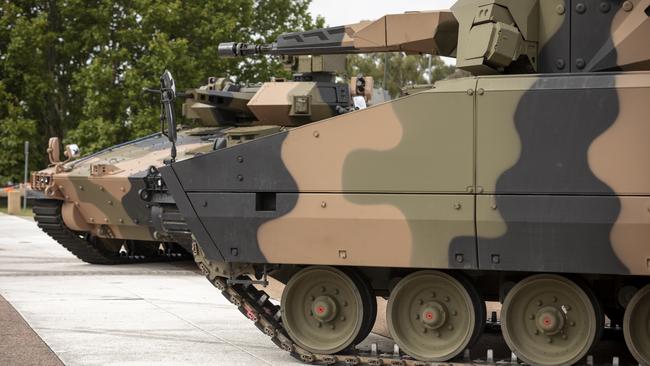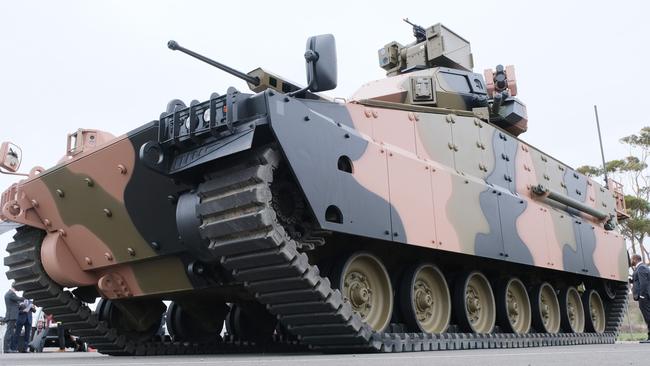Army takes delivery of infantry fighting vehicles (IFVs) for testing
The competition to chose next generation heavily armoured infantry fighting vehicles (IFV) has entered its most critical phase. The two bidders have now handed over three vehicles each to the Army.

The competition to choose next generation tracked, heavily armoured infantry fighting vehicles (IFV) under Land 400 Phase 3 has entered its most critical phase.
The two bidders — Rheinmetall from Germany, with the Lynx, and South Korea’s Hanwha, offering the Redback — have now handed over three vehicles each to the army.
For the past several months the companies have been training uniformed Australian personnel in the IFVs’ operation and support, and they will have minimal involvement from now on.
The six vehicles will now be extensively tested in various harsh environments, from deserts to the tropics, and one from each supplier will be blast tested to the point of destruction, to find out how tough they really are.
If everything goes to schedule, this phase will end in October, and after that the paperwork will go through the Defence committee system, with a recommendation in mid-2022 — probably just in time for the federal election campaign.
Worth anywhere between $18bn and $27bn, the project is by far the most expensive in army’s history, and will provide up to 450 platforms able to carry between six and eight fully armed soldiers, plus a crew of three, into high-intensity combat. They will be an integral part of combined arms operations, working in conjunction with M1A1 main battle tanks, artillery, helicopters and air support.
To perform these missions, they need to be well protected as well as fast, agile and heavily armed with a combination of 30mm automatic cannon and antitank guided missiles.
From a distance, the Redback and the Lynx look similar but there are a number of major differences. Each was short-listed on the basis it would be able to meet the army’s stringent requirements — especially for protection.

The Redback is somewhat lighter, at 42 tonnes, compared with 45 tonnes for the Lynx, and has achieved this with a number of innovations, most noticeably the use of rubber tracks.
As well as being lighter than traditional metal links, they are much quieter and — importantly for the infantry sitting inside the IFVs — generate less vibration, which greatly reduces fatigue on longer missions. The Lynx uses a turret also made by Rheinmetall, which will be common to those on the 8x8 Boxer combat reconnaissance vehicles being supplied to the army under the earlier Land 400 Phase 2. Known as the Lance, this is currently being modified to incorporate customer improvements and its main weapon is a Mauser 30mm cannon.
In contrast, the Redback uses an Israeli turret that will be packed with sensors developed by Australian company EOS.
It will use a Bushmaster 30mm chain gun from US supplier Northrop Grumman, which is one of the most common weapons for armoured vehicles in the Western world.
The Mauser uses specialised steel-cased ammunition while the Bushmaster consumes more common aluminium-cased rounds, due to the different firing mechanisms involved. The Bushmaster is externally powered and the ammunition is fed into the breach in a manner resembling a high-speed bottling machine.
The Mauser has a classic and more violent system, whereby the force of each exploding cartridge blows the breech back and open, to accept the next round. Both can fire a variety of programmable projectiles, from armour piercing through to airburst munitions with a range of about 3km.
Both turrets will carry two Spike antitank guided missiles mounted externally in specialised containers. The Redback turret has undertaken numerous firing tests in Israel but the status of the Lance is less clear, with the Defence Department refusing to supply specific details about the integration effort on the Boxer vehicles.
What is clear is that Spike is a formidable anti-armour weapon that is able to lock on a target and fly automatically to it, while still giving the operator a manual override that allows aiming points to be updated until the last second.
Combined with the 30mm cannon and coaxial 7.62mm machine gun, these vehicles are designed to hold their own against anything except for a head-on engagement with an enemy main battle tank.
Both Hanwha and Rheinmetall have put together comprehensive Australian industry packages, and will continue to develop those right up until a winner is announced. If chosen, the Lynx will be built at Rheinmetall’s massive vehicle integration facility at Ipswich, which is currently producing Boxers. The Redback will be built in the Geelong area at a new plant to be opened to produce 155mm self-propelled howitzers, which Hanwha will soon be contracted to supply.
Whichever is chosen, army will be receiving arguably the most advanced and best-protected IFVs in the world.
The Lynx has already been ordered by Hungary and the South Korean Army is known to have a strong interest in the Redback.
Both Rheinmetall and Hanwha are also competing for the biggest order of them all: next generation armoured vehicles for the US army.


